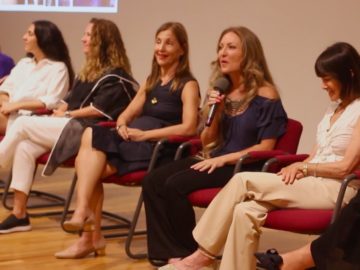Science and Technology Highlights from UCSB Materials Research Symposium
BY LEAH KURITZKY
The Materials Research Laboratory (MRL) at the University of California, Santa Barbara (UCSB) promotes research of its affiliated faculty, students, and alumni in part through its annual research symposium, which took place on Feb. 2-3 2016.
The symposium featured research topics related to chemical and materials sciences that are poised to impact our health, environment, and quality of life. Highlights of this year’s event included speakers: Dr. Matthew Gebbie of UCSB Materials, Prof. Michelle O’Malley of UCSB Chemical Engineering, Prof. Srabanti Chowdhury of UC Davis Electrical Engineering (formerly at Arizona State University), and Dr. Bryce Meredig of Citrine Informatics.
From the Ocean to the Operating Room
Recent UCSB graduate, Dr. Matthew Gebbie explained the motivation for his research with the personal story of his shoulder surgery, during which doctors drilled screws directly into his bone to anchor sutures to the damaged tendon. These screws can lead to longer recovery and increased pain after operation.
Dr. Gebbie is looking to nature for clues on how to replace screws with bio-inspired wet adhesives. Marine mussel shellfish, for example, use protein-based glues to secure themselves to their rocky stations amidst the powerful force of crashing waves. Dr. Gebbie and his colleagues use lab-synthesized proteins to study the nature of the adhesive force, which is governed by molecular forces of attraction including electrostatics and cation-pi interactions.
Chemical Breakthroughs Using Gut Fungi
UCSB’s Prof. Michelle O’Malley “is motivated by the abundance of non-food biomass sources that are usually burned for energy.” She sees an opportunity to use this replenishable source of plant matter as a raw material for producing value-added chemicals, such as pharmaceuticals. Her group investigates the anaerobic gut microbes of large herbivores that are efficient at breaking down the tough cell walls of plants.
Some of these gut fungi were among the earliest microbes to evolve on the planet, and their primitiveness correlates to their ability to break down a large variety of food stocks. The “higher” fungi, on the other hand, evolved to eat more specific foods. Prof. O’Malley’s group has sequenced the genomes of some of these microbes with the goal of understanding how to mix and match microbes to optimize the chemical breakdown of plant matter.
Materials to Supersede Silicon for Electronics
Prof. Srabanti Chowdhury, discussed her work at Arizona State University on materials used for power electronics, which are the unseen devices that manage power input and output for everyday technologies including LEDs, solar cells and hybrid electric vehicles. Traditionally, power electronics are made of silicon, but newer electronic materials including diamond and gallium nitride have the potential to be more energy efficient.
Diamond is known for its gem status and its industrial use in cutting and drilling due to its exceptional hardness. Diamond is now gaining recognition for its favorable electronic properties such as its high thermal conductivity, which can aid heat management in power electronics. Gallium nitride is a manmade material which also demonstrates high thermal and electrical performance. This material is also the basis of the ubiquitous blue LED.
Open-Access and Searchable Platform for Chemical Data
A recent startup, Citrine Informatics, has taken on the task of organizing and cataloguing the tremendous volume of data generated by materials researchers and chemists worldwide.
Co-founder and CEO, Dr. Bryce Meredig explained how the company leverages its eight employees’ expertise in materials and computer science to build algorithms to collect and sort datasets containing chemical and materials properties. They provide free upload and download of public data by National Labs and academics, and they turn a profit by consulting for industry customers with product-oriented goals such as shinier paint, tougher phones or lighter vehicles.
These goals are more easily achieved when information about relevant materials properties is organized and available for analysis.
The MROP is an annual research symposium. For more information, please see UCSB MRL.






